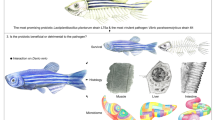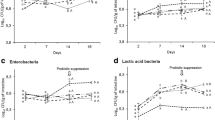Abstract
A critical feature of probiotic microorganisms is their ability to colonize the intestine of the host. Although the microbial potential to adhere to the human gut lumen has been investigated in in vitro models, there is still much to discover about their in vivo behaviour. Zebrafish is a vertebrate model that is being widely used to investigate various biological processes shared with humans. In this work, we report on the use of the zebrafish model to investigate the in vivo colonization ability of previously characterized probiotic lactic acid bacteria. Lactobacillus plantarum Lp90, L. plantarum B2 and Lactobacillus fermentum PBCC11.5 were fluorescently tagged by transfer of the pRCR12 plasmid, which encodes the mCherry protein and which was constructed in this work. The recombinant bacteria were used to infect germ-free zebrafish larvae. After removal of bacteria, the colonization ability of the strains was monitored until 3 days post-infection by using a fluorescence stereomicroscope. The results indicated differential adhesion capabilities among the strains. Interestingly, a displacement of bacteria from the medium to the posterior intestinal tract was observed as a function of time that suggested a transient colonization by probiotics. Based on fluorescence observation, L. plantarum strains exhibited a more robust adhesion capability. In conclusion, the use of pRCR12 plasmid for labelling Lactobacillus strains provides a powerful and very efficient tool to monitor the in vivo colonization in zebrafish larvae and to investigate the adhesion ability of probiotic microorganisms.







Similar content being viewed by others
References
Arena MP, Russo P, Capozzi V, López P, Fiocco D, Spano G (2014) Probiotic abilities of riboflavin-overproducing Lactobacillus strains: a novel promising application of probiotics. Appl Microbiol Biotechnol 98:7569–7581
Avella MA, Place A, Du SJ, Williams E, Silvi S, Zohar Y, Carnevali O (2012) Lactobacillus rhamnosus accelerates zebrafish backbone calcification and gonadal differentiation through effects on the GnRH and IGF systems. PLoS ONE 7:e45572
Bove P, Russo P, Capozzi V, Gallone A, Spano G, Fiocco D (2013) Lactobacillus plantarum passage through an oro-gastro-intestinal tract simulator: carrier matrix effect and transcriptional analysis of genes associated to stress and probiosis. Microbiol Res 168:351–359
Bricker AL, Camilli A (1999) Transformation of a type 4 encapsulated strain of Streptococcus pneumoniae. FEMS Microbiol Lett 172:131–135
Bron PA, Van Baarlen P, Kleerebezem M (2012) Emerging molecular insights into the interaction between probiotics and the host intestinal mucosa. Nat Rev Microbiol 10:66–78
Carnevali O, Avella MA, Gioacchini G (2013) Effects of probiotic administration on zebrafish development and reproduction. Gen Comp Endocrinol 188:297–302
Chen YP, Chen MJ (2013) Effects of Lactobacillus kefiranofaciens M1 isolated from kefir grains on germ-free mice. PLoS One 8:e78789
Chudakov DM, Lukyanov S, Lukyanov KA (2005) Fluorescent proteins as a toolkit for in vivo imaging. Trends Biotechnol 23:605–613
Cronin M, Sleator RD, Hill C, Fitzgerald GF, van Sinderen D (2008) Development of a luciferase-based reporter system to monitor Bifidobacterium breve UCC2003 persistence in mice. BMC Microbiol 8:161
Davis C (2014) Enumeration of probiotic strains: review of culture-dependent and alternative techniques to quantify viable bacteria. J Microbiol Methods 103:9–17
de Vrese M, Schrezenmeir J (2008) Probiotics, prebiotics, and synbiotics. Adv Biochem Eng Biotechnol 111:1–66
Dothel G, Vasina V, Barbara G, De Ponti F (2013) Animal models of chemically induced intestinal inflammation: predictivity and ethical issues. Pharmacol Ther 139:71–86
Douillard FP, de Vos WM (2014) Functional genomics of lactic acid bacteria: from food to health. Microb Cell Factories 13(S1):S8
Fernández de Palencia P, López P, Corbí AL, Peláez C, Requena T (2008) Probiotic strains: survival under simulated gastrointestinal conditions, in vitro adhesion to Caco-2 cells and effect on cytokine secretion. Eur Food Res Technol 227:1475–1484
Fernández de Palencia P, Werning ML, Sierra-Filardi E, Dueñas MT, Irastorza A, Corbí AL, López P (2009) Probiotic properties of the 2-substituted (1,3)-beta-D-glucan-producing bacterium Pediococcus parvulus 2.6. Appl Environ Microbiol 75:4887–4891
Foligné B, Daniel C, Pot B (2013) Probiotics from research to market: the possibilities, risks and challenges. Curr Opin Microbiol 16:284–292
Garai-Ibabe G, Dueñas MT, Irastorza A, Sierra-Filardi E, Werning ML, López P, Corbí AL, Fernández de Palencia P (2010) Naturally occurring 2-substituted (1,3)-beta-D-glucan producing Lactobacillus suebicus and Pediococcus parvulus strains with potential utility in the production of functional foods. Bioresour Technol 101:9254–9263
García-Cayuela T, de Cadiñanos LP, Mohedano ML, Fernández de Palencia P, Boden D, Wells J, Peláez C, López P, Requena T (2012) Fluorescent protein vectors for promoter analysis in lactic acid bacteria and Escherichia coli. Appl Microbiol Biotechnol 96:171–181
García-Ruiz A, González de Llano D, Esteban-Fernández A, Requena T, Bartolomé B, Moreno-Arribas MV (2014) Assessment of probiotic properties in lactic acid bacteria isolated from wine. Food Microbiol 44:220–225
Gioacchini G, Maradonna F, Lombardo F, Bizzaro D, Olivotto I, Carnevali O (2010) Increase of fecundity by probiotic administration in zebrafish (Danio rerio). Reproduction 140:953–959
Gioacchini G, Giorgini E, Merrifield DL, Hardiman G, Borini A, Vaccari L, Carnevali O (2011a) Probiotics can induce follicle maturational competence: the Danio rerio case. Biol Reprod 86:65
Gioacchini G, Lombardo F, Merrifield DL, Silvi S, Cresci A, Avella MA, Carnevali O (2011b) Effects of probiotics on Zebrafish reproduction. J Aquac Res Dev S1:002
Karlsson J, von Hofsten J, Olsson PE (2001) Generating transparent zebrafish: a refined method to improve detection of gene expression during embryonic development. Mar Biotechnol (NY) 3:522–527
Lacks S (1968) Genetic regulation of maltosaccharide utilization in Pneumococcus. Genetics 60:685–706
Landete JM, Peirotén Á, Rodríguez E, Margolles A, Medina M, Arqués JL (2014) Anaerobic green fluorescent protein as a marker of Bifidobacterium strains. Int J Food Microbiol 175:6–13
Lebeer S, Vanderleyden J, De Keersmaecker SCJ (2008) Genes and molecules of lactobacilli supporting probiotic action. Microbiol Mol Biol Rev 72:728–764
Lebeer S, Claes IJ, Verhoeven TL, Vanderleyden J, De Keersmaecker SC (2011) Exopolysaccharides of Lactobacillus rhamnosus GG form a protective shield against innate immune factors in the intestine. Microb Biotechnol 4:368–374
Mainville I, Arcand Y, Farnworth ER (2005) A dynamic model that simulates the human upper gastrointestinal tract for the study of probiotics. Int J Food Microbiol 99:287–296
Maradonna F, Gioacchini G, Falcinelli S, Bertotto D, Radaelli G, Olivotto I, Carnevali O (2013) Probiotic supplementation promotes calcification in Danio rerio larvae: a molecular study. PLoS ONE 8:e83155
Marco ML, Pavan S, Kleerebezem M (2006) Towards understanding molecular modes of probiotic action. Curr Opin Biotechnol 17:204–210
Meeker ND, Trede NS (2008) Immunology and zebrafish: spawning new models of human disease. Dev Comp Immunol 32:745–757
Milligan-Myhre K, Charette JR, Phennicie RT, Stephens WZ, Rawls JF, Guillemin K, Kim CH (2011) Study of host–microbe interactions in zebrafish. Methods Cell Biol 105:87–116
Mohedano ML, García-Cayuela T, Pérez-Ramos A, Gaiser AR, Requena T, López P (2015) Construction and validation of a mCherry protein vector for promoter analysis in Lactobacillus acidophilus. J Ind Microbiol Biotechnol. doi:10.1007/s10295-014-1567-4
Nieto C, Espinosa M, Puyet A (1998) The maltose/maltodextrin regulon of Streptococcus pneumonia: differential promoter regulation by the transcriptional repressor MalR. J Biol Chem 276:14946–14954
Nikolic M, López P, Strahinic I, Suárez A, Kojic M, Fernández-García M, Topisirovic L, Golic N, Ruas-Madiedo P (2012) Characterisation of the exopolysaccharide (EPS)-producing Lactobacillus paraplantarum BGCG11 and its non-EPS producing derivative strains as potential probiotics. Int J Food Microbiol 158:155–162
Notararigo S, Casas-Engel MDL, Fernández de Palencia P, Corbí AL, López P (2014) Immunomodulation of human macrophages and myeloid cells by 2-substituted (1-3)-β-D-glucan from P. parvulus 2.6. Carbohydr Polym 112:109–113
Nüsslein-Volhard C, Dahm R (2002) Zebrafish. A practical approach. Oxford University Press, New York
Pham LN, Kanther M, Semova I, Rawls JF (2008) Methods for generating and colonizing gnotobiotic zebrafish. Nat Protoc 3:1862–1875
Projan SJ, Carleton S, Novick RP (1983) Determination of plasmid copy number by fluorescence densitometry. Plasmid 9:182–190
Ramos CL, Thorsen L, Schwan RF, Jespersen L (2013) Strain-specific probiotics properties of Lactobacillus fermentum, Lactobacillus plantarum and Lactobacillus brevis isolates from Brazilian food products. Food Microbiol 36:22–29
Rendueles O, Ferrières L, Frétaud M, Bégaud E, Herbomel P, Levraud JP, Ghigo JM (2012) A new zebrafish model of oro-intestinal pathogen colonization reveals a key role for adhesion in protection by probiotic bacteria. PLoS Pathog 8:e1002815
Rieu A, Aoudia N, Jego G, Chluba J, Yousfi N, Briandet R, Deschamps J, Gasquet B, Monedero V, Garrido C, Guzzo J (2014) The biofilm mode of life boosts the anti-inflammatory properties of Lactobacillus. Cell Microbiol 16:1836–1853
Rojo I, de Ilárduya OM, Estonba A, Pardo MA (2007) Innate immune gene expression in individual zebrafish after Listonella anguillarum inoculation. Fish Shellfish Immunol 23:1285–1293
Runft DL, Mitchell KC, Abuaita BH, Allen JP, Bajer S, Ginsburg K, Neely MN, Withey JH (2014) Zebrafish as a natural host model for Vibrio cholerae colonization and transmission. Appl Environ Microbiol 80:1710–1717
Russo P, López P, Capozzi V, Fernández de Palencia P, Dueñas MT, Spano G, Fiocco D (2012) Beta-glucans improve growth, viability and colonization of probiotic microorganisms. Int J Mol Sci 13:6026–6039
Russo P, Capozzi V, Arena MP, Spadaccino G, Dueñas MT, López P, Fiocco D, Spano G (2014) Riboflavin-overproducing strains of Lactobacillus fermentum for riboflavin-enriched bread. Appl Microbiol Biotechnol 98:3691–3700
Sánchez B, Ruiz L, Gueimonde M, Margolles A (2013) Omics for the study of probiotic microorganisms. Food Res Int 54:1061–1071
Saxelin M (2008) Probiotic formulations and applications, the current probiotics market, and changes in the marketplace: a European perspective. Clin Infect Dis 46:S76–S79
Sullivan C, Kim CH (2008) Zebrafish as a model for infectious disease and immune function. Fish Shellfish Immunol 25:341–350
Turpin W, Humblot C, Thomas M, Guyot JP (2010) Lactobacilli as multifaceted probiotics with poorly disclosed molecular mechanisms. Int J Food Microbiol 143:87–102
Turpin W, Humblot C, Guyot JP (2011) Genetic screening of functional properties of lactic acid bacteria in a fermented pearl millet slurry and in the metagenome of fermented starchy foods. Appl Environ Microbiol 77:8722–8734
Turpin W, Humblot C, Noordine ML, Thomas M, Guyot JP (2012) Lactobacillaceae and cell adhesion: genomic and functional screening. PLoS One 7:e38034
Turpin W, Humblot C, Noordine ML, Wrzosek L, Tomas J, Mayeur C, Cherbuy C, Guyot JP, Thomas M (2013) Behavior of Lactobacilli isolated from fermented slurry (ben-saalga) in gnotobiotic rats. PLoS ONE 8:e57711
van der Sar AM, Appelmelk BJ, Vandenbroucke-Grauls CM, Bitter W (2004) A star with stripes: zebrafish as an infection model. Trends Microbiol 12:451–457
van Tassell ML, Miller MJ (2011) Lactobacillus adhesion to mucus. Nutrients 3:613–636
Zhou Z, Wang W, Liu W, Gatlin DM, Zhang Y, Yao B, Ringø E (2012) Identification of highly-adhesive gut Lactobacillus strains in zebrafish (Danio rerio) by partial rpoB gene sequence analysis. Aquaculture 370–371:150–157
Acknowledgments
We sincerely thank Dr. César Martín Plágaro (UPV/EHU, Leioa, Spain) for confocal microscopy analysis. We thank Dr. Stephen Elson for the critical reading of the manuscript.
The work performed in Spain was supported at the Centro de Investigaciones Biológicas by grant AGL2012-40084-C03-01 from the Spanish Ministry of Economics and Competitiveness and at AZTI-Tecnalia by the “Departamento de Desarrollo Económico y Competitividad Viceconsergería de Agricultura, Pesca y Politicas Alimentarias” (Project FOODBASK3). Iñaki Iturria is a recipient of a PhD fellowship from Iñaki Goenaga Foundation.
The work performed in Italy was supported by the Italian Ministry for Development in the framework of the “Industria 2015 Bando Nuove Tecnologie per il Made in Italy—Realizzazione di una innovativa pasta alimentare funzionale arricchita di componenti bioattivi e probiotici”, and by MIUR (PON02_00186_2937475) in the framework of the project named “Protocolli innovativi per lo sviluppo di alimenti funzionali” “(Pro.Ali.Fun.)”.
Author information
Authors and Affiliations
Corresponding author
Additional information
Russo Pasquale and Iturria Iñaki contributed equally to this work.
Electronic supplementary material
Below is the link to the electronic supplementary material.
ESM 1
(PDF 195 kb)
Rights and permissions
About this article
Cite this article
Russo, P., Iturria, I., Mohedano, M.L. et al. Zebrafish gut colonization by mCherry-labelled lactic acid bacteria. Appl Microbiol Biotechnol 99, 3479–3490 (2015). https://doi.org/10.1007/s00253-014-6351-x
Received:
Revised:
Accepted:
Published:
Issue Date:
DOI: https://doi.org/10.1007/s00253-014-6351-x




